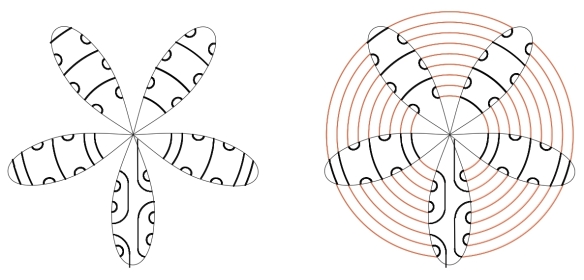In my last post I have shown that a seed pattern can also be drawn in labyrinths with multiple arms (see related posts). With the seed pattern for the Ariadne’s Thread it is possible to connect the arms in the shape of a flower (or a propeller). For each arm, a separate petal is needed.
These auxiliary figures can all be drawn in one continous line.
Fig. 2 illustrates this with a three-arm labyrinth. Other flowers with multiple arms can be drawn the same way.
Each of the petals contains a part-seed pattern. I will show this using an example of one of my five-arm labyrinth designs. I choose the design KS 2-3 that has been installed as a temporary labyrinth on the square of Magdeburg cathedral. This labyrinth can be actually seen in the header of this blog. Otherwise there is an image of it here.
Fig. 3 shows the labyrinth in a drawing by Erwin of the walls and with the Ariadne’s Thread (red) inscribed.
In fig. 4 the seed pattern for the Ariadne’s Thread is shown per se and completed to the whole Ariadne’s Thread. In order to complete this seed pattern, for each circuit 10 ends have to be connected with five segments of a circuit. Evidently, with an increasing number of arms, the seed pattern comes to look closer to the entire labyrinth. The part-circuits are shortened in relation to the part-seed patterns.
The seed pattern has first and most often been published for the walls of the Cretan type labyrinth. Also for several other one-arm labyrinths, seed patterns have been published. Therefore, the seed pattern does not constitute a characteristic attribute of the Cretan type labyrinth. It is not even a characteristic specific for one-arm labyrinths alone.
However, the use of seed patterns in labyrinths with multiple arms is of minor practical importance. The original purpose and meaning of the seed pattern was, that it enables us to capture the essential of a labyrinth with a simple memorable system of lines that allows us to generate the labyrinth straight away. And this applies best to the seed patterns of the Cretan type labyrinth and its relatives of the vertical line.
Fig. 5 shows the seed patterns for the walls in the first column and for the Ariadne’s Thread in the second column. The corresponding types of labyrinths are on
- row 1: Löwenstein 3
- row 2: The Cretan
- row 3: Hesselager
- row 4: Tibble
Related Posts
- The Seed Pattern in Labyrinths with Multiple Arms
- The Cretan at the Crossing Point
- A Temporary Labyrinth on the Magdeburg Domplatz






It is not my first time to pay a visit this web page, i am
browsing this website dailly and take nice data from here daily.
LikeLike